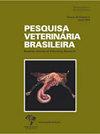Outbreak of leishmaniasis caused by Leishmania enriettii in guinea pigs (Cavia porcellus)
IF 0.8
4区 农林科学
Q3 VETERINARY SCIENCES
引用次数: 0
Abstract
ABSTRACT: We describe an outbreak of leishmaniasis in seven guinea pigs (Cavia porcellus) in which nodular ulcerated skin lesions of varying sizes were observed in the nasal cavity, upper lip, pinnae, vulva, and periarticular region of the limbs. Cytologic exam of collected samples of the lesions in the auricle of one of the animals revealed macrophages containing parasitophorous vacuoles of approximately 4.0μm in diameter in their cytoplasm with morphology suggestive of Leishmania sp. Although skin lesions spontaneously regressed in two of the Guinea pigs, only one survived. All six animals that died were necropsied. Grossly, all animals showed bloody nodular cutaneous lesions with crusts. One of the guinea pigs had distended dark red and firm lungs. Histopathology of the skin lesions revealed histiocytic interstitial acanthotic dermatitis associated with a myriad of Leishmania organisms within macrophages cytoplasm. In the lung, the lesions were characteristic of broncho-interstitial pneumonia with focal infiltrates of neutrophils, epithelioid macrophages, and multinucleated giant cells containing 2µm basophilic amastigotes with morphology compatible with Leishmania spp. A focal granulomatous lesion ,associated with the causal agent in the lung is a novel description of leishmaniasis in guinea pigs caused by L. enriettii. The polymerase chain reaction (PCR) technique with mini-exon primer performed in samples of lesions from two affected guinea pigs was positive and equal to the reference strain, identifying Leishmania enriettii. The cytological, macroscopic, and histological lesions associated with the PCR technique allowed the diagnosis of leishmaniasis and the identification of the specie L. enriettii.豚鼠中由埃利什曼原虫引起的利什曼病暴发
摘要:我们描述了7只豚鼠(Cavia porcellus)爆发利什曼病,其中在鼻腔,上唇,耳廓,外阴和四肢关节周围区域观察到不同大小的结节性溃疡性皮肤病变。对其中一只豚鼠耳廓病变标本进行细胞学检查,发现巨噬细胞细胞质中含有直径约4.0μm的寄生液泡,形态提示利什曼原虫。尽管两只豚鼠皮肤病变自发消退,但只有一只存活。所有死亡的六只动物都进行了尸检。肉眼可见,所有动物均表现为带痂的带血结节性皮肤病变。其中一只豚鼠的肺呈暗红色,肿胀而坚硬。皮肤病变的组织病理学显示组织细胞间质棘突性皮炎与巨噬细胞细胞质内无数利什曼原虫有关。在肺部,病变具有支气管间质性肺炎的特征,局灶性浸润中性粒细胞、上皮样巨噬细胞和含有2µm嗜碱性无梭菌的多核巨细胞,其形态与利什曼原虫相一致。与肺部病原体相关的局灶性肉芽肿病变是利什曼原虫引起的豚鼠利什曼病的新描述。在两只受感染豚鼠的病变样本中进行了带有迷你外显子引物的聚合酶链反应(PCR)技术,结果为阳性,与参考菌株相同,鉴定出了恩利什曼原虫。与PCR技术相关的细胞学、宏观和组织学病变允许利什曼病的诊断和利氏L.的鉴定。
本文章由计算机程序翻译,如有差异,请以英文原文为准。
求助全文
约1分钟内获得全文
求助全文
来源期刊

Pesquisa Veterinaria Brasileira
农林科学-兽医学
CiteScore
1.30
自引率
16.70%
发文量
41
审稿时长
9-18 weeks
期刊介绍:
Pesquisa Veterinária Brasileira - Brazilian Journal of Veterinary Research (http://www.pvb.com.br), edited by the Brazilian College of Animal Pathology in partnership with the Brazilian Agricultural Research Organization (Embrapa) and in collaboration with other veterinary scientific associations, publishes original papers on animal diseases and related subjects. Critical review articles should be written in support of original investigation. The editors assume that papers submitted are not being considered for publication in other journals and do not contain material which has already been published. Submitted papers are peer reviewed.
The abbreviated title of Pesquisa Veterinária Brasileira is Pesqui. Vet. Bras.
 求助内容:
求助内容: 应助结果提醒方式:
应助结果提醒方式:


